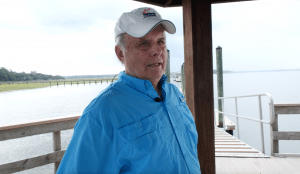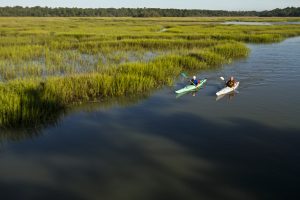From 118 Strokes a Minute to “Slowcountry Sailing”
Meet the Olympian who Kickstarted Kayaking at Callawassie
When you hear Callawassie Paddler’s Club Co-Founder John Pagkos share the journey of his incredible paddling experiences, he nearly buries the lead — making Callawassie and its residents the star, while his own accomplishments seem like the postscript. As you listen to the rhythm of his storytelling, you’ll realize he tells the story like he rows: starting and stopping, with wide, even strokes, pointing out moments of interest as if they were birds in the sweetgrass. All the while, he takes momentary pauses to soak it all in — telling of unbelievable experiences ranging from 9/11 patrols in regional waterways to paddling by the Pope to even attending and competing in the Olympic Games. Blending his northeast accent with the sound of the southeast birds in the background, he meanders through his tale as he takes you out on the water.
Feats of Olympic Measure

While putting the boat in, you’ll be transported back to 1949 when Pagkos was just a teenager getting his start in paddling. At the time, his uncle was training for the 1952 Olympics and Pagkos knew three others who had gone on to compete in the 1936 games. Paddling was not just instilled in his DNA, it surrounded him in his neighborhood. “There were three clubs within 15 miles,” Pagkos says with an air of nostalgia: the Yonkers Canoe Club (Pagkos’ paddling alma matter, founded in 1886 and now known as the Yonkers Paddling and Rowing Club), Pendleton, and Inwood, at the tip of Manhattan. “Out of that group,” Pagkos recalls, “We sent at least 20 paddlers to the Olympics, including three repeaters: myself, my partner, and a couple of fellas out of Inwood — bringing back two gold and a silver medal from my club.”
After this quick nod to what most would consider an incredible athletic pedigree, he moves on as quickly as Navy Swift Boats, which was his next feat.
“After the Olympics, I was on a destroyer out of Newport, Rhode Island and finished up my service. When I got back, I didn’t figure I was going to get back in the game,” Pagkos says. “My brothers and his friends had already been training and were in excellent shape. But all I heard was ‘C’mon Johnny, c’mon back,’ so I bought myself an outboard. It was brutal starting from scratch again. They really gave me the business in practice and beat me, but they never got by me in a race.
Paddling Around the Globe
Pagkos describes a heyday that includes globe-hopping to points from Australia to Canada to Rome. “All the fellas picked up a 500-meter leg, so I wound up in Lake Albano waving at the Pope,” he says in aside as casually as he recalled his Olympic qualification. “We were affiliated with the American Canoe Association, the governing body for selecting the Olympic teams back in late ‘40s and ‘50s, training
fellas to go to the Olympics. It was fortunate, after my uncle got back from the Olympics in ’52, they started the North American Championships and selected the three top senior paddlers in the United States in six events, so I paddled in Montreal, Lachine, and Winnipeg. I got to Sudbury, Ontario and gave the top Canadian paddlers some scares.” Though he doesn’t dwell on it, he was clocked at 118 strokes per minute, even before advancements of today’s high-tech gear. To put that in perspective, the Journal of Applied Biomechanics published a study in 2015 on stroke rates in elite sprint kayaking, analyzing paces ranging from 60 to 100 strokes per minute (spm). The report refers to training at high stroke rates (SRs) and “a variety of training paces that can go from 55 spm up to 140 spm.” Clearly, Pagkos is upper league.
Callawassie Paddler’s Club: Setting the Bar
Now, Pagkos says he’s most comfortable as an instructor. He paints an impressive picture of the Callawassie Paddler’s Club as setting the local bar for participation, as the club includes all ranges of experience from those just learning to paddle to former pros. He honors Jack Krumpe who launched the club with him in 2004. Pagkos says, “Jack was also involved in major sports up in the New York area – the Knickerbockers, Rangers, and

Saratoga Racing. We were both involved in the local Coast Guard Auxiliary for a time including during 9/11, patrolling the waters from Savannah up into Dataw and Saint Helena Sound, and we thought we’d give setting up the club a try, not expecting many people. Maybe 25-30. Ten minutes after we started there was standing room only.”
That level of interest has never waned at Callawassie. Starting out with three other “go-to guys” as instructors with paddling experience, Pagkos describes an enthusiasm that had immediate momentum — kind of like his paddle rate. Our first treasurers were from Wells Fargo and Chase Manhattan. We quickly had 90 members, and as we took off, the club grew as an attraction to younger ages, children and teens.”
What has changed, however, is the equipment. Of his historic experience on world waters, Pagkos says, “I wish I was in it now with the technology and what that does for the boats and performance. Everything was wooden back then – boats, paddles – and now it’s fiber glass, carbon fiber, Kevlar. I picked up a wooden paddle for $25 in the Olympics. Today, some of the high-end Wing Blades cost about $400. The old training we had in the ‘40s, ‘50s, ‘60s wouldn’t catch these guys today. Between the training style, the science, and the high-tech equipment, in a 1000-meter race they’re probably easily 100-meters faster. You figure they cover three or four football fields in four minutes. That’s moving. They’re sailing.”
Forging Community
For Pagkos, the most enjoyable part of both the sport and the club is progress. “Anytime you go out there with a group to see the progress that’s being made and how much the sport has grown here over time and keeps growing, it’s remarkable.” The club’s fast and furious beginnings would be small compared to what the club has become today. As Pagkos explains, “We have 240 members now, and 93 boats racked as you drive onto the island.” It’s a real visual of the growing passion for not just paddling, but also the community that is forged when you put a few boats in the water among friends.
Learn more about the clubs and events at Callawassie Island here!
